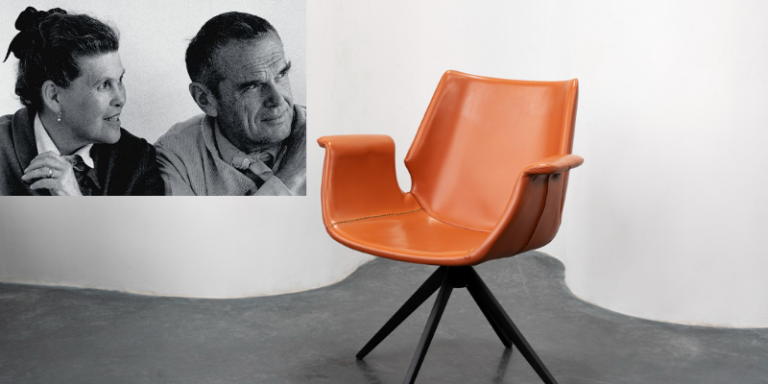It’s difficult to imagine chair design without thinking of Charles Eames’s groundbreaking designs. Modernity, style, and comfort—qualities that have characterized some of the most recognizable furniture designs of the 20th century—are all associated with his name. Charles and his wife, Ray Eames, transformed the furniture industry with ground-breaking inventions that influenced mid-century modernism and still influence modern design. Eames gave furniture new life with each curve and contour, demonstrating that seating could be both aesthetically pleasing and useful.
Eames produced experiences rather than merely chairs. Perhaps his most famous design, the Eames Lounge Chair, is more than just a seat; it’s a timeless representation of elegance and comfort. Eames’ genius was his ability to create chairs that were not only incredibly durable but also comfortable by fusing cutting-edge materials with simple design. His use of plastic, fiberglass, and molded plywood changed how designers approached mass production and allowed them to provide consumers with extremely sophisticated yet reasonably priced furniture. His creations continue to serve as a superb illustration of how design can be innovative without sacrificing accessibility.
Charles Eames, Chair Designer: Essential Details in a Flash
Here is a brief summary of Chair Designer Charles’s career and contributions to the design industry for those who want to learn more about his significant work.
| Name | Charles Eames (1907–1978) |
|---|---|
| Profession | Industrial Designer, Architect, Filmmaker |
| Notable Works | Eames Lounge Chair, Molded Plywood Chairs, Eames Dining Chair |
| Collaborator | Ray Eames (wife and design partner) |
| Notable Contributions | Pioneering ergonomic design, mass production of molded plywood furniture |
| Materials Innovated | Molded Plywood, Fiberglass, Plastic |
| Awards & Recognition | Royal Gold Medal (1979), AIA Twenty-five Year Award (1977) |
| Legacy | Highly influential in furniture design, ergonomics, and modern aesthetics |
| Website for More Info | Eames Office |
Charles, the Chair Designer’s Influence: An Innovative Legacy
Charles Eames, a chair designer, introduced a daring new method of furniture design that prioritized utility over style. Considering the materials he invented, his chairs were revolutionary for the furniture industry. Charles and Ray Eames turned molded plywood, which had few uses prior to their inventions, into a material that was both practical and pleasing to the eye. This method aimed to improve people’s perceptions of commonplace items rather than merely producing furniture. The Eames Molded Plywood Chairs are the ideal illustration of how design can combine functionality and aesthetics.
Charles Eames gained recognition for his extremely effective material use over time. His chairs were expertly molded, with each component created with the user in mind. He made ergonomics a top priority, designing seats that were not only aesthetically pleasing but also incredibly comfortable. For many years, the Eames Lounge Chair has been praised for its comfort, and its classic style has made it a favorite in offices and homes all over the world. Eames produced chairs that were highly adaptable and could be used in a range of settings while still adding a touch of refinement thanks to his creative use of materials and ground-breaking design techniques.
The Eames Design Concept: Harmonizing Comfort and Beauty
The extraordinary ability of Chair Designer Charles to blend comfort and beauty is among his most enduring contributions. Charles Eames concentrated on both, producing pieces that were not only incredibly comfortable but also stylish, in contrast to many other designers who might choose one over the other. His chairs were made to naturally support the body by emphasizing ergonomic design, which made them incredibly functional without compromising style. This idea was embodied in the 1956 design of the Eames Lounge Chair and ottoman, which was elegant yet functional and classic at the same time.
It should come as no surprise that Eames’ contributions are still honored today. His products are built to last for many generations and are incredibly dependable. In addition to being innovative, the materials he used, such as fiberglass and molded plywood, guaranteed that each piece would be incredibly durable. Eames was able to create furniture that would be in style for many years to come by combining a sleek, contemporary design with an emphasis on long-term comfort. In many respects, his designs, which reflected the social changes of the era, came to represent postwar optimism.
A Tradition That Still Motivates Contemporary Designers
Charles, the chair designer, continues to have an impact on modern designers’ work. The most inventive designs of today were made possible by his investigation of novel materials and methods. Eames established a new benchmark for furniture design with his willingness to try molding plywood, fiberglass, and plastic into useful pieces. By pushing the limits of design, he transformed the furniture market and made design more widely available without sacrificing comfort or quality.
Eames chairs, made by renowned brands like Herman Miller and Vitra, are still in great demand today. To ensure that his legacy endures, these businesses still produce Eames Lounge Chairs and molded plywood chairs. The fact that Charles Eames’ creations are still as relevant today as they were when they were first created, however, may be their most enduring quality. His creations serve as a constant source of inspiration for both designers and homeowners, demonstrating the timeless nature of excellent design.
The remarkable legacy of chair designer Charles Eames is proof of the potency of fusing creativity, functionality, and form. His ability to produce fashionable and ergonomic furniture raised the bar for the furniture industry and still has an impact on design today. His creations provide a unique fusion of classic style and contemporary utility, whether in the molded plywood chairs or the well-known Eames Lounge Chair. Charles Eames’ contributions to the field of design have had a lasting impact, and his designs continue to serve as a stunning illustration of how furniture can be both functional and artistic.


